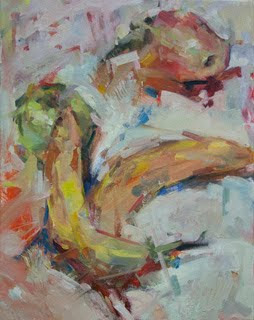 As a MFA-Painting degree student at the Academy of Art University, San Francisco, I'm required to keep a journal describing my activities, the outcome of my thesis project and the changes in directions and thinking about my art, or art in general.
As a MFA-Painting degree student at the Academy of Art University, San Francisco, I'm required to keep a journal describing my activities, the outcome of my thesis project and the changes in directions and thinking about my art, or art in general.This semester has started quite well. I'm taking two directed study classes and one elective. Zhaoming Wu is my directed study advisor and the other class is Expressive Painting, with Baoping Chen. I've been having constant conversations with them, regarding my thinking, my work and my direction for the remainder of my school time.
This past week I had a nice talk with Baoping. It was a review of what I've been doing and then a few suggestions and statements about where I should start aiming at in order to further develop my art into a new level of value and meaning.
I have been, for the past year or so, trying to experiment applying non-representative strokes, shapes and colors into what could be considered a realistic approach to painting, specially with the figure. So with that I've seen myself try a set of different techniques and experiment with a wide variety of shapes, painting wet over wet, emphasizing edges, and all of the many concerns one must have with any painting, regardless of style.
I was showing him two paintings of mine, one was an abstract portrait and the other, a quick still life study. The still life was to me definitely more successful since it had a lot of unity in color, enough information to tell those were fruits we were looking at, but still the strokes are very lively and meaningful, making it an exciting painting to look at, regardless of the subject.
Baoping agreed with me and thought the still life was better. He went on about something very important to him, which is one of the true values of an artist and his painting: emotion. It is hard to say that we're not expressing anything on a painting, or that a painting has no emotion. The point was that with the abstract style, the emotion becomes very important, because in traditional realism, an artist might seek to replicate something that was done before, and might get very very close to matching it, or even to the untrained eye, he might achieve it. An abstract painting, when expressive and emotional, is virtually impossible to mimic, for even if they're planned, there's a bit of carelessness on every mark that will influence it's landing on the canvas, there's emotion and motion and thickness and texture that simply can't fully be replicated, not even by the same artist.
The uniqueness that great art requires can obviously be achieved in any style, even the most photo-realistic, but when we're talking about something as subjective as abstract art, expressive or semi-abstract, then it's uniqueness has the potential to be unparalleled. That's a value that has to always be considered while creating art. The unique emotion of that one painting day. The emotion of the artist. The emotion of the canvas' surface.
Also, he said, it is very important to know when to stop. In realism, the painting will tell you when yo stop, which is when it's done. You can fix a little detail, add some light, but if you're going for that perfect representation, then there's always a way to tell, which does require an incredibly well trained eye, but is still a little more clear than with abstract. When abstracting your subject into something totally or mostly interpreted on canvas, then the eye needs to be trained in a slightly different way. Which still requires all the observational training of painting traditionally, but there's probably a higher need of looking at and analyzing your own painting. The subject must be considered and understood, but mostly for inspiration and some information, but in no way will it ever determine the outcome or be decisive in the success of the painting. It's the eye of the artist that needs to be able to critique its own creations and be able to make good decisions on top of whatever shapes and colors are laid out.
It's been a great semester so far and my instructors are definitely pushing me to try harder both with working and with thinking. I believe this particular talk was of great importance an definitely added to my way of perceiving value in my art. I hope it has a similar effect on you and your work.
No comments:
Post a Comment